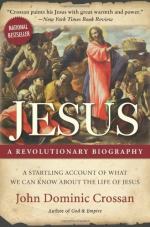
|
| Name: _________________________ | Period: ___________________ |
This test consists of 15 multiple choice questions and 5 short answer questions.
Multiple Choice Questions
1. What two things do the quotes at the beginning of Part Seven contemplate?
(a) Love and hate.
(b) Death and life.
(c) Beauty and Charisma.
(d) Fun and depression.
2. Which Greek philosophers does the author say inspired Jesus?
(a) Virgil.
(b) Socrates.
(c) Plato.
(d) The Cynics.
3. What disease of contemporary society does the author talk about in this section?
(a) Cancer.
(b) AIDS.
(c) Consumption.
(d) Measles.
4. How was James different from Jesus?
(a) He had a huge family.
(b) He had social and economic status.
(c) He was not spiritual.
(d) He lived on the streets.
5. Who does the author say was not a robber?
(a) Barabbas.
(b) Judas.
(c) Pilate.
(d) James the Just.
6. What does the author say is the most controversial aspect of his argument?
(a) Denying Jesus' existance.
(b) Claiming Jesus was not original.
(c) Claiming they killed the wrong man.
(d) Factualizing the Crucifixion.
7. What does the author think that Jesus' casting out of demons is a metaphor for?
(a) The casting off of the ego.
(b) The casting off of hate.
(c) The casting off of oppressive authority.
(d) The casting off of family restrictions.
8. Which of the following constraints does the author say Jesus lived under?
(a) Food.
(b) Gender.
(c) Love.
(d) Marraige.
9. What does the author define disease as?
(a) A social stigma.
(b) A personal hell.
(c) An individual experience.
(d) A soul destroyer.
10. Where was the unnamed woman from?
(a) Nazareth.
(b) Jeruselum.
(c) Bethleham.
(d) Bethany.
11. What does the author say the resurrection stories were based on?
(a) New Testament prohecies.
(b) Jewish legend.
(c) Old Testament prophecies.
(d) Greek legend.
12. Who does the author say reinterprets the circumstances of Jesus' death?
(a) The People's Movement.
(b) The Egyptians.
(c) The Christian Movement.
(d) The Romans.
13. What is the meal that the author mentions in Part Seven?
(a) Sausage and gravy.
(b) Beef stew.
(c) Biscuits and gravy.
(d) Bread and fish.
14. What does the author say the stories of Jesus' resurrection were metaphoric interpretations of?
(a) The idea that there is only one God.
(b) The decline of Roman rule.
(c) The people's need for a savior.
(d) The growth of Christian faith.
15. What does the author say must be present for oppressed groups to revolt?
(a) A weak government.
(b) Strong family structure.
(c) Hatred of authority.
(d) Great desperation.
Short Answer Questions
1. What does the author say that miraculous is the primary anchor of?
2. Who would eat the remains of a man left on a cross?
3. What does the author say defined the actions and intentions of anyone who helped write the New Testament?
4. Which of Jesus' disciples was known as the Beloved Disciple?
5. What does the author say Jesus' crucifixion was based upon?
|
This section contains 439 words (approx. 2 pages at 300 words per page) |

|




